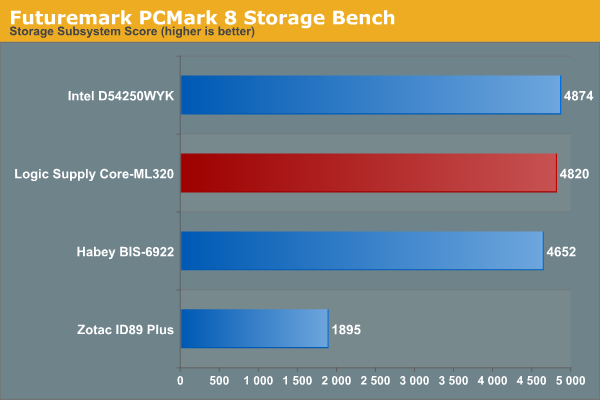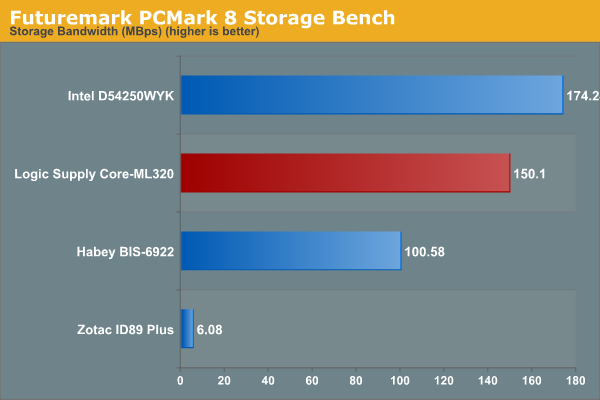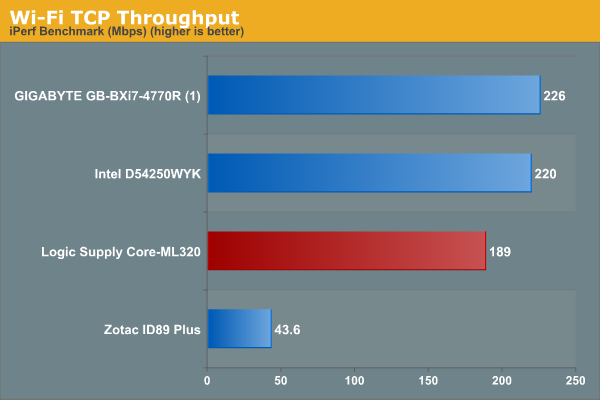Logic Supply Core-ML320 Fanless Industrial NUC Review
by Ganesh T S on April 30, 2014 3:45 PM EST- Posted in
- NUC
- Industrial PC
- Passive Cooling
- Logic Supply
Storage & Wireless Networking Credentials
Starting with this review, we have decided to devote a separate section to analyze the storage and networking credentials of the units under review. On the storage side, one option would be repetition of our strenuous SSD review tests on the drive(s) in the PC. Fortunately, to avoid that overkill, PCMark 8 has a storage bench where certain common workloads such as loading games and document processing are replayed on the target drive. Results are presented in two forms, one being a benchmark number and the other, a bandwidth figure. We ran the PCMark 8 storage bench on selected PCs and the results are presented below.
In using the PCMark 8 storage benchmark, our intent is to test the primary drive in the system. Our review sample of the Core-ML320 shipped with a 32 GB mSATA SSD as the primary drive. After the installation of the OS and adding in a couple of updates, we were down to less than 2 GB of free space on the drive. PCMark 8's storage bench, unfortunately, required more free space, and we ended up using the secondary drive (the 60 GB 2.5" SSD) for this test.


On the networking side, we restricted ourselves to the evaluation of the WLAN component. Our standard test router is the Netgear R7000 Nighthawk configured with both 2.4 GHz and 5 GHz networks.
Netgear R7000 Nighthawk Testbed Router
The router is placed approximately 20 ft. away, separated by a drywall (as in a typical US building). A wired client (Zotac ID89-Plus) is connected to the R7000 and serves as one endpoint for iPerf evaluation. The PC under test is made to connect to either the 5 GHz (preferred) or 2.4 GHz SSID and iPerf tests are conducted for both TCP and UDP transfers. It is ensured that the PC under test is the only wireless client for the Netgear R7000.
We evaluate total throughput for up to 32 simultaneous TCP connections using iPerf and present the highest number in the graph below.

In the UDP case, we try to transfer data at the highest rate possible for which we get less than 1% packet loss.

We find that the PCs equipped with 802.11ac WLAN cards perform better than the 802.11n ones. For the Core-ML320, the choice of a 2x2 dual band 802.11n card (Intel Centrino Advanced-N 6235) help in delivering very good numbers. In fact, the numbers are very close to the AC7260-equipped Intel NUC kit.











31 Comments
View All Comments
PCfan720 - Wednesday, April 30, 2014 - link
The base system is around $650, which is only a couple hundred bucks more than the standard NUC with a fan that Intel offers. A couple hundred bucks isn't bad for a completely sealed and fanless unit.WithoutWeakness - Thursday, May 1, 2014 - link
The NUC is also barebones. The price of comparable RAM and an MSATA SSD should be included in the price of the NUC for a fair comparison.eBob - Thursday, May 1, 2014 - link
This isn't really intended for a home or office user. When you have things running on the factory floor, reliability becomes a more overriding concern. These systems often end up running ten and even twenty years and often without software updates. I would imagine that a lot of these systems are destined to be locked in control cabinets with other hardware and forgotten about unless something goes wrong.Morawka - Thursday, May 1, 2014 - link
how did you build a NUC for under 300 when the barebones is $365? and that's not even counting $50 RAM, $70 Intel Wireless and $60 hard drive + $6 Power CordHrel - Wednesday, April 30, 2014 - link
What's gong on with the Habey on the 7zip test? Shouldn't Gigabyte still be way ahead?ganeshts - Wednesday, April 30, 2014 - link
We weren't able to run 7-Zip on the BRIX Pro (1) configuration because we no longer have access to that particular configuration. You can see updated benchmarks in our second part of the BRIX Pro review that will use different DRAM / storage. I will be posting that shortly.senthil.c - Wednesday, April 30, 2014 - link
It is very disappointing that most NUC does not comes with the IR sensor built-in, since these kind of PC's are mostly used in home theatre environment, IR sensor is a must needed feature.PCfan720 - Thursday, May 1, 2014 - link
The ML320 does have an IR sensor, it's pictured in the main image and listed in the spec table on the Logic Supply site (http://www.logicsupply.com/core-ml320/). Did you just mean that in general most NUC systems don't have one?Antronman - Wednesday, April 30, 2014 - link
Wouldn't make bad HTPCs.No IR, but not bad. A little bit on the pricey side though...for 1000-1300USD you're not looking at an HTPC, but a low-end gaming PC.
harshw - Thursday, May 1, 2014 - link
There's also the Akasa Newton H. It's smaller, cheaper ( in the UK at least. US prices are a laugh ) and with a bit of modding for LEDs - it is perfectly acceptable as a HTPCMine does 41c/50c for the CPU/SSD at an ambient of 27c
http://www.scan.co.uk/products/akasa-newton-h-alum...
The default LEDs for all these cases are usually a blindingly bright blue for power and an anemic green/yellow for HDD. I modded mine to have a warm daylight dim white LED for power and a dim blue for HDD activity. Wish manufacturers had more sense ...